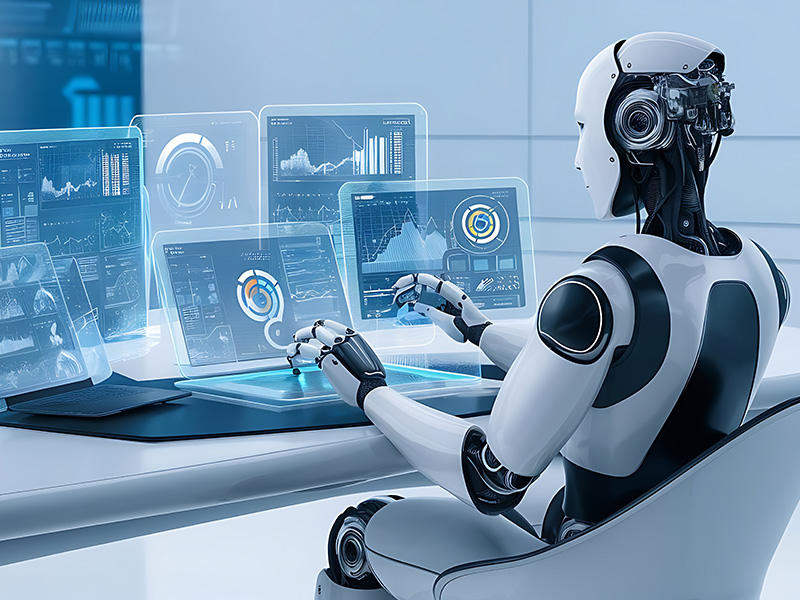AI plays a pivotal role in the digital transformation of the manufacturing sector, driving efficiency, innovation, and competitiveness. Here’s how AI is reshaping manufacturing:
1. Predictive Maintenance
- Role: AI algorithms analyze data from sensors embedded in machinery to predict when equipment is likely to fail or require maintenance. This involves processing vast amounts of real-time data to identify patterns and signs of potential issues.
- Impact: Predictive maintenance reduces downtime, extends equipment life, and minimizes the costs associated with unexpected breakdowns. It ensures that maintenance is performed only when necessary, optimizing operational efficiency.
2. Process Optimization
- Role: AI models optimize manufacturing processes by analyzing data from production lines to identify inefficiencies and suggest improvements. Machine learning algorithms can adjust parameters in real-time to enhance production quality and speed.
- Impact: Enhanced process optimization leads to increased productivity, reduced waste, and improved product quality. Manufacturers can respond more quickly to changes in demand and minimize resource usage, leading to cost savings.
3. Quality Control and Inspection
- Role: AI-powered computer vision systems are used to inspect products on the production line, detecting defects or deviations from quality standards. These systems can analyze images or videos of products faster and more accurately than human inspectors.
- Impact: Automated quality control ensures consistent product quality, reduces the rate of defective products, and lowers the costs associated with rework and recalls. It also allows for continuous monitoring, improving overall manufacturing standards.
4. Supply Chain Optimization
- Role: AI enhances supply chain management by predicting demand, optimizing inventory levels, and improving logistics. AI models analyze data from various sources, including market trends, weather patterns, and consumer behavior, to forecast demand more accurately.
- Impact: Improved supply chain optimization leads to reduced inventory costs, minimized stockouts and overstock situations, and enhanced ability to meet customer demand. This results in more agile and responsive supply chains.
5. Robotics and Automation
- Role: AI is integral to the development of smart robotics and automation systems that perform complex tasks on the production line. These systems can learn and adapt to new tasks, work alongside human workers, and handle repetitive or dangerous jobs.
- Impact: AI-driven robotics and automation increase production efficiency, improve safety by reducing the need for human intervention in hazardous environments, and allow
- volumes.
6. Design and Product Development
- Role: AI assists in product design and development by analyzing customer feedback, market trends, and historical data to suggest new features or design improvements. Generative design algorithms can explore multiple design alternatives based on predefined parameters.
- Impact: This accelerates the product development cycle, reduces time-to-market, and ensures that products meet customer expectations and market needs. It also fosters innovation by enabling the exploration of a broader range of design possibilities.
7. Energy Management
- Role: AI optimizes energy consumption in manufacturing facilities by monitoring energy use, predicting future energy needs, and suggesting energy-saving measures. AI can also coordinate the operation of energy-intensive equipment to minimize peak demand charges.
- Impact: Improved energy management leads to significant cost savings, reduced environmental impact, and compliance with energy efficiency regulations. It also contributes to the sustainability goals of manufacturing companies.
8. Human-Machine Collaboration
- Role: AI enhances human-machine collaboration by providing workers with augmented reality (AR) tools, real-time data analytics, and decision support systems. These tools help workers perform their tasks more efficiently and safely.
- Impact: Enhanced collaboration improves productivity, reduces errors, and increases worker satisfaction by reducing the cognitive load and physical strain associated with manual tasks.
9. Custom Manufacturing and Mass Personalization
- Role: AI enables custom manufacturing by analyzing customer preferences and tailoring production processes to create personalized products on a large scale. This involves integrating AI into the design, production, and supply chain processes.
- Impact: Custom manufacturing and mass personalization allow manufacturers to offer unique products that meet individual customer needs, creating a competitive advantage and opening up new market opportunities.
10. Data-Driven Decision Making
- Role: AI-powered analytics tools process large volumes of manufacturing data to provide actionable insights for decision-makers. This includes optimizing production schedules, resource allocation, and overall plant management.
- Impact: Data-driven decision-making improves operational efficiency, enhances strategic planning, and allows manufacturers to respond quickly to changes in the market or production environment.
In summary, AI is transforming the manufacturing sector by improving operational efficiency, enhancing product quality, reducing costs, and enabling greater flexibility and innovation. Through AI-driven digital transformation, manufacturers can remain competitive in a rapidly changing global market and better meet the demands of customers and stakeholders.

